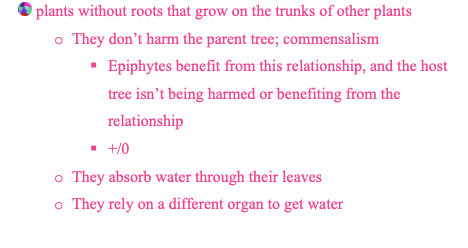TOPIC 11- Plant Nutrition
1/39
Name | Mastery | Learn | Test | Matching | Spaced |
|---|
No study sessions yet.
40 Terms
water co2
_____ and ____ goes in during photosynthesis
oxygen sugar
____ and ____ goes out during photosynthesis
oxygen sugar
____ and ___ goes in during cellular respiration
water co2
____ and ___ goes out during cellular respiration
g3p
sugar product of photosynthesis
symplast route
solutes move through the cytoplasm (plasmodesmata channels) that connect plant cells
doesn’t cross any membranes
apoplast route
solutes go through the cell wall
transmembrane route
solutes are pumped out of the membrane and the into neighbouring cells
cross cell membranes
root hair
during the apoplast route water enter from the __ __
caspian strip
water absorption in the root when following the apoplast route is controlled at the ___ ___
it stops the water from moving in the apoplast route, and directs it into the symplast route once it encounters the endodermis
endodermis
barrier important in regulation plant water absorption
root hair membrane
control for root water absorption following the symplast route is controlled at the ___ ___ ___
short distance
____ ____ transport occurs at the cellular level
transmembrane
primary active transport, secondary active transport, and facilitated diffusion are 3 types of ____ transport
primary active transport
a type of transmembrane transport that uses a proton pump fueled by ATP
moves protons against their concentration gradient
secondary active transport
type of transmembrane transport that involves moving protons down their concentration gradient while simultaneously moving another solute up their respective gradient
this is called cotransport
facilitated diffusion
solute moving down its concentration gradient with the help of protein ion channels
passive transport
high low
water always moves from areas of ___ pressure to ___ pressure
zero
pure water has a water potential of
pressure potential
the sum of all forces acting on water, like gravity
turgid cells
____ have a higher solute concentration than their surroundings, which causes the cells to plump up because water is moving into the cell
guttation
the physical pumping of water out of the leaves of small, vascular plants
is a result a buildup of water and minerals in the roots
to balance this out the plant releases excess water through their leaves
only happens at night, during the day the stomata performs a similar purpose
transpiration
long distance transport
xylem sap
water solution that contains water, minerals and hormones
flows from root to shoot; ground up
phloem sap
water solution that contains photosynthates and hormones
flows in both directions depending on time of year
cohesion-tension mechanism
plants move xylem sap through ____-____ ____
combination of cohesion and adhesion
cohesion
during the cohesion-tension mechanism, the ___ part is due to water molecules’ attraction to themselves
water molecules are attracted to each other because they are polar molecules
adhesion
during the cohesion-tension mechanism, the ____ is due to water sticking to the walls of the xylem
this is how water can move against the forces of gravity from root to shoot
more effective with narrower tubes, like in capillaries
stomata
regulated transpiration
small openings in the leaf epithelium that regulate transpiration and gas exchange; allows plant to breathe
close
potassium loss causes the stomata to __
bulk flow
phloem transport method that moves phloem sap from source cell to sink cell
source cell
leaf cell in the summer, and root cells in the spring
site of sugar production and the break down of starch in the spring
source of CO2
sink cell
seeds, fruits, flowers, roots, and storage organs
stores and uses CO2
minerals
secondary tissues can’t absorb ____
trichome
bulk of water is absorbed at the ____ zone
negatively
soil is ___ charged which makes it easier for cationic minerals to be absorbed by roots
acidic
plants make the soil more ___ so they can absorb anions easier
they do this by diffusing CO2 out of the root which interacts with water to make bicarbonate and protons
epiphytes

parasite

carnivore
